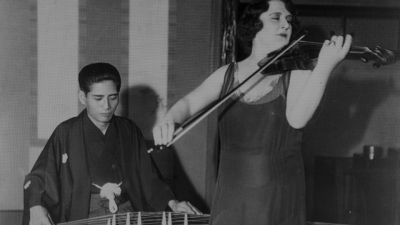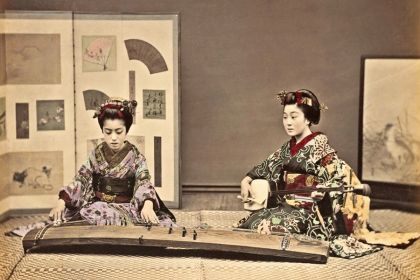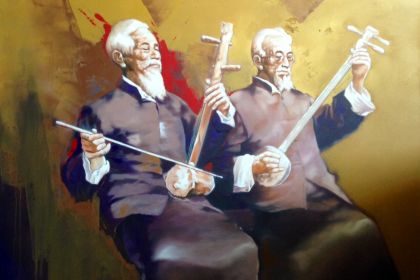Koto
Michio Miyagi & Renée Chemet: near century-old collaboration of koto and violin linking Japanese traditions with Western classic

Michio Miyagi and Renée Chemet
Music Period: 20st Century Classical
Country: Japan
Genre: Folk
Composer: Michio Miyagi (宮城 道雄)
Artist: Renée Chemet
Piece of Music: Haru no Umi (春の海)
In the first half of the 20th century, many Asian composers sought a way to represent their cultures on the global scene by interweaving folk melodies into the harmonized structure of Western classical music.
The seminal steps taken in this direction were made by the Japanese composer Michio Miyagi who not only created numerous arrangements of his native music but also perfected the koto harp, making it a full-fledged orchestral instrument.
Born in 1894 in Kobe, Michio Miyagi was a sickly child suffering from eye and ENT diseases which resulted in complete loss of vision at the age of eight. This tragic misfortune was a turning point in the boy's life: he became resolute in studying music the koto harp—the oldest Japanese instrument known from the 7th century.
By the age of eighteen, having deeply studied the folk repertoire, he perfectly mastered koto but his subtle understanding of musical harmony encouraged him to create his own works, which ultimately made him the founder of Shin Nihon Ongaku—new Japanese music.
Miyagi's music gained great popularity in the country through live radio broadcasts in the mid-1920s as well as many concert tours in which he was accompanied by other artists who supported the new direction of traditional music. In 1929, the composer wrote his most famous work, Haru no Umi (The Sea in Spring) inspired by an image of the sea of Tomonoura that he had seen before losing his eyesight.
Watch Haru no Umi performed on koto and shakuhachi flute:
Haru no Umi, originally written for koto and the Japanese bamboo flute, soon reached an international audience after Michio Miyagi's collaboration with French violinist Renée Chemet who heard his music during her international tour in 1932.
Renée Chemet reworked the flute part for the violin, giving a new texture to the meditative melody by using the vibrato to evoke the image of light on the sea surface. Some musicologists remark on the unusual timbre of the violin in the piece, explaining the nature of the sound by Renée Chemet's use of the silk strings to make her violin closer to Japanese bowed folk instruments such as the kokyū.
Listen to Michio Miyagi & Renée Chemet perform Haru no Umi:
During his life, Michio Miyagi received recognition not only as a musician and composer but also as an essayist and author of ten books. He has also established himself as an excellent teacher at the Tokyo College of Music and the Academy of Arts of Japan.
As with Miyagi's early days, his death was also shadowed by hapless tragedy. During his touring the country, he fell out of the train by mixing up the doors after his loss of orientation in the surrounding space.
Even though he survived this accident, Michio Miyagi died in the hospital several hours later on June 25, 1956.



